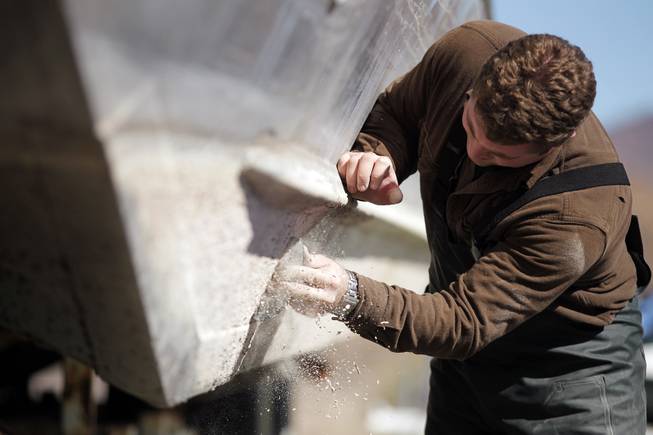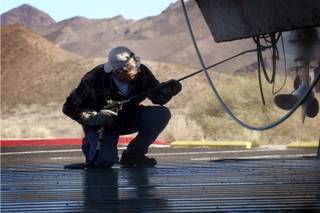
Chase Raymond of Demaris Enterprises, a pressure washing company based in Salem, Ore., scopes the side of a boat to remove quagga mussels as part of the Watercraft Inspection Training class at Callville Bay in Lake Mead National Recreation Area on Wednesday, February 13, 2013.
Wednesday, Feb. 13, 2013 | 4:31 p.m.
Map of Lake Mead National Recreation Area
Bruce Williams squinted as he used a high-pressure hose spraying 140-degree water to kill and blast away quagga mussels from under a hulking houseboat.
Williams, a vessel inspector at a county lake in Santa Clara, Calif., traveled this week to Lake Mead to take part in a two-day class to learn more about how to stop the spread of the invasive mollusk.
“Down the road you know you’re going to have to spend millions and millions on your infrastructure over and over again,” he said. “We don’t have ’em and we don’t want ’em.”
The shellfish has clung to boat hulls in droves and gummed up aquatic engines nationwide. And they continue to spread. A garden-variety, 15-foot boat can take about three hours to clean. The houseboat – which measured more than 60 feet in length –- could take three weeks to decontaminate.
“This is by far the worst invasive species in the world,” said Ashlie Watters, quagga mussel program coordinator for the Lake Mead National Recreation Area.
That’s her opinion, she said, but consider the numbers: The handful of decontamination centers at Lake Mead each cost $425,000 and put the cost of dealing with the crustaceous critter well into the millions. The creature causes millions of dollars in damage to boats too; it’s reached more than a trillion in number at the lake, and, Watters said, the shellfish smells.
That’s not all. She said the mussel can harm infrastructure, like intake pipes feeding into the Hoover Dam. Millions of the mollusks can cram into a single square meter of space and can almost entirely halt water flow through plumbing or an intake pipe.
Shawn Gerstenberger, associate dean of the School of Community Health Sciences at UNLV, said the critters initially came from Ukraine and have spread across Europe and America. Lake Mead saw its first case in 2007.
“Like most invasive species, they seem to be able to adapt to different environments and displace the other native species,” he said. “Right now they’ve pretty much dominated the bottom of (Lake Mead).”
The quagga mussel is a formidable opponent to native species because each of the tiny creatures can filter a liter of water a day, stripping it of algae.
The ubiquitous quagga mussel may just be a small, fleshy blob protected in a shell, but it’s caused big problems. So big that uninfected lakes throughout the West are in danger of contracting the invasive species.
Gersternberger said these particular mussels forced hundreds of millions of dollars in expenses nationwide and because there is no effective way to eradicate them, they’re likely to spread.
David Wong, an adjunct professor at UNVLV and professor of biology at the State University of New York in Oneonta, said about 80 percent of freshwater sources in North America have been infested by quagga mussels – and they won’t stop there.
“Each lake will be infected. One by one. Little by little,” he said. “We have to find a way to stop their progress.”
Prevention is the best way to slow the progress of the mussels, experts agree. Watters’ prevention program happens every month and draw attendees from near and far, from Utah to North Dakota to Montana.
Signs around the lake read in part “Don’t Move a Mussel” and attempt to get the message across. Watters is making sure people heed the warning in hopes of sparing other lakes from the same expensive problem.


Join the Discussion:
Check this out for a full explanation of our conversion to the LiveFyre commenting system and instructions on how to sign up for an account.
Full comments policy